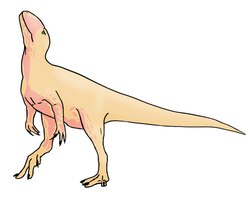The Elrhaz Formation is a geological formation in Niger, West Africa.
Its strata date back to the Early Cretaceous, about 125 to 112 million years ago. Dinosaur remains are among the fossils that have been recovered from the formation, alongside those of multiple species of crocodyliformes.

Gadoufaoua (Tuareg for "the place where camels fear to go") is a site within the Elrhaz Formation (located at 16°50′N 9°25′E / 16.833°N 9.417°E) in the Tenere desert of Niger known for its extensive fossil graveyard. It is where remains of Sarcosuchus imperator, popularly known as SuperCroc, were found (by Paul Sereno in 1997, for example), including vertebrae, limb bones, armor plates, jaws, and a nearly complete 6 feet (1.8 m) skull.


Gadoufaoua is very hot and dry. Based on the sedimentary and fossil record, Gadoufaoua had trees, plants, and wide rivers 112 million years ago. The river covered the remains of dead animals, the fossilized remains of which were protected by the drying rivers over millions of years.[1]
| Chondrichthyes | ||||
|---|---|---|---|---|
| Genus | Species | Material | Notes | Images |
| Hybodus[2] | H. sp. | Dorsal spines[2] |  | |
| Sarcopterygii | ||||
|---|---|---|---|---|
| Genus | Species | Material | Notes | Images |
| Asiatoceratodus[2] | A. tiguidiensis[2] | Dipnomorph fish. Originally described as Ceratodus tiguidiensis,[3] assigned to Arganodus by M. Martin (1984)[4] and reassigned by Kemp (1998) to the genus Asiatoceratodus.[5] | ||
| Mawsonia[6] | M. tegamensis[6] | A small species.[7] |  | |
| Neoceratodus[2] | N. africanus[2] | Tooth plates.[8] | Dipnomorph fish. Originally described as Ceratodus africanus, assigned to Neoceratodus by M. Martin, 1982.[9] |  |
| Actinopterygii | ||||
|---|---|---|---|---|
| Genus | Species | Material | Notes | Images |
| Pliodetes[10] | P. nigeriensis[10] | Skull and postcranial material including body scales.[11] | Originally thought to be a semionotid, later assigned to Lepisosteoidei.[11] |  |
| Pycnodontidae indet.[2] | Indeterminate | |||
| Testudines | ||||
|---|---|---|---|---|
| Genus | Species | Material | Notes | Images |
| Francemys[12] | F. gadoufaouaensis[12] | "Shell of a juvenile individual and several articulated and disarticulated plates."[12] | Pelomedusoid turtle. Named in honour of France de Lapparent de Broin.[12] | |
| Taquetochelys[13] | T. decorata[13] | A few disarticulated plates and nearly complete skeleton.[14] | Araripemydid turtle, similar in shell size to South American Araripemys (20–30 cm). Laganemys tenerensis was synonymysed with Taquetochelys by Pérez-García, 2018.[14] | |
| Teneremys[13] | T. lapparenti[13] | "Several relatively complete skeletons."[12] | ||
| Crocodyliformes | ||||
|---|---|---|---|---|
| Genus | Species | Material | Notes | Images |
| Anatosuchus[15] | A. minor[15] | "Nearly complete skull" |  | |
| Araripesuchus[15] | A. wegeneri[15] | "Nearly complete skull" |  | |
| Sarcosuchus[16] | S. imperator | "Partial skeletons, numerous skulls" |  | |
| Stolokrosuchus | S. lapparenti | |||
| Ornithischians | |||||
|---|---|---|---|---|---|
| Genus | Species | Material | Notes | Images | |
| Elrhazosaurus[15] | E. nigeriensis[15] | "Femora."[17] | A dryosaurid |  | |
| Lurdusaurus[15] | L. arenatus[15] | "Partial skull, fragmentary postcranial skeleton."[18] |  | ||
| Ouranosaurus[15] | O. nigeriensis[15] | "Skull and poscrania, second skeleton."[19] |  | ||
| Theropods | |||||
|---|---|---|---|---|---|
| Genus | Species | Material | Notes | Images | |
| Afromimus | A. tenerensis | "caudal vertebrae, chevrons and portions of the right hind limb"[20] | A putative noasaurid[21] |  | |
| Cristatusaurus[22] | C. lapparenti[22] | Jaw bones and vertebral fragments.[22] | A spinosaurid potentially synonymous with Suchomimus[23] |  | |
| Eocarcharia[15] | E. dinops[24] | "Partial skull and postcranial remains."[25] | Known from chimaeric remains; the holotype and skull roof material likely derive from a baryonychine spinosaurid, while the referred maxilla is from a carcharodontosaurid.[26] |  | |
| Kryptops[15] | K. palaios[15] | Postcranial skeleton and partial skull.[27] | An abelisaurid |  | |
| Suchomimus[15] | S. tenerensis[15] | Partial skull and associated skeleton.[28] | A baryonychine spinosaurid |  | |
| Sauropods | ||||
|---|---|---|---|---|
| Genus | Species | Material | Notes | Images |
| Nigersaurus | N. taqueti | Skull and skeletal remains | A rebbachisaurid. |  |
| Plants | ||||
|---|---|---|---|---|
| Genus | Species | Material | Notes | Images |
| Paradoxopteris[29] | P. stromeri | A tree fern and member of Matoniaceae. | ||
| Protophyllocladoxylon | P.chudeaui | A conifer[29] | ||
{{citation}}: CS1 maint: publisher location (link)